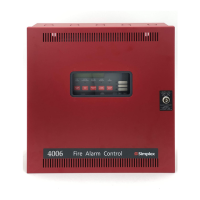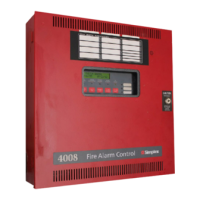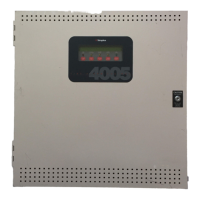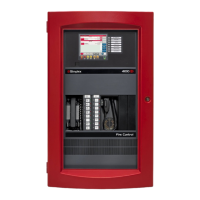8-12
Chapter 8 EPS and IDNet 2 Wiring
IDNet 2 Card Wiring (continued)
Class B Wiring When wiring the loop for Class B circuits, both the B+, B- and A+, A- terminals are available
for parallel connections. Within the IDNet 2 circuitry, A+ is connected to B+, and A- is
connected to B- so circuits can stem from either one. Additionally, two wires can be connected
to each screw terminal.
To wire the Loop terminals as a Class B circuit:
Figure 8-10. IDNet 2 Class B Wiring
Class B wiring Notes:
1. If no remote isolators or isolator bases are on the loops, device addressing can be assigned
without concern for sequence.
2. If remote isolators or isolator bases are on the loops, the required addressing approach is to start at
the output and assign each successive isolator a higher address than the isolator it proceeds. For
Class B wiring only, the “A” output and “B” output per loop are connected together in parallel for
wiring convenience.
1. Set the jumper assigned to the loop to the “B” position, as shown in
Figure 8-9.
• Loop 1 = Jumper P1 on the IDNet 2 card
• Loop 2 = Jumper P2 on the IDNet 2 card
• Loop 3 = Jumper P1 on the left IDNet Loop card
• Loop 4 = Jumper P1 on the right IDNet Loop card
2. Route wiring from the Primary Terminals (B+, B-) to the corresponding
inputs on the first device.
It is possible to add up to 4 circuits per IDNet loop on the terminal block
when using Class B wiring. See Figure 8-10 for the diagram.
3. Route wiring from the first device to the next as in/out as shown in
Figure 8-10. Repeat for each device.
Figure 8-9. Class B
Jumper Setting
B+ B- A+ A-
IDNet CIRCUIT A
B+
TB1
1
B- A+ A-
Devices
B+, B-
Terminals
2
1
4
3
Note: For Class B wiring only, up to 4 parallel wiring “T”
taps may be made at the output terminal blocks
B+ B- A+ A-
2
1
2 Circuit Configuration
4 Circuit Configuration
Different Circuit Configurations

